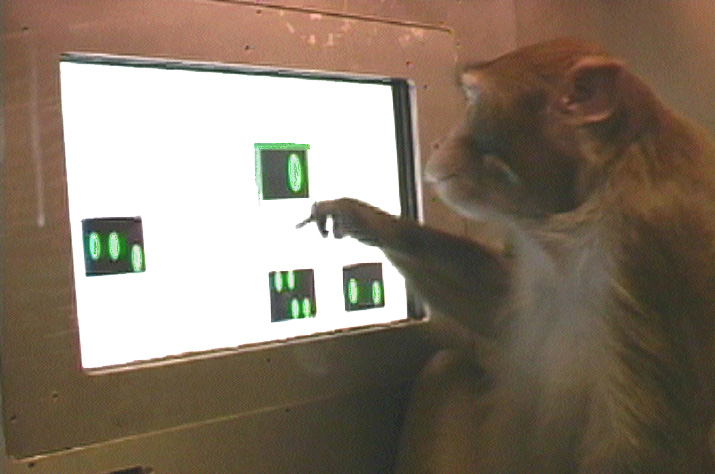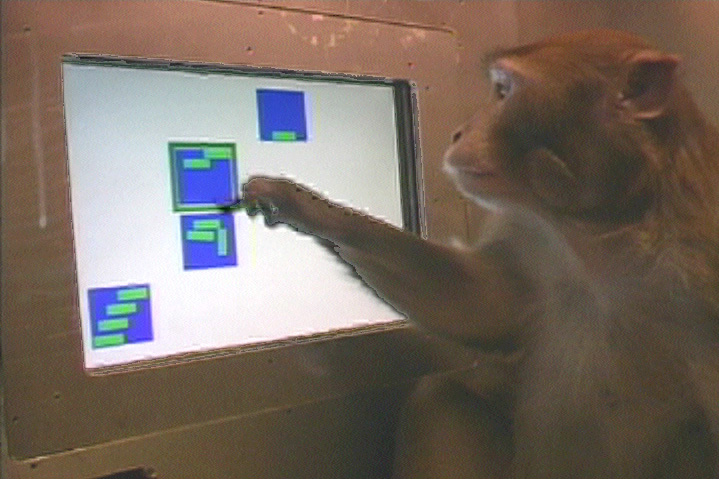The animal cognitive revolution. Recent research on animal cognition challenges the traditional Cartesian view that animals cannot think because they lack language. Experiments on delayed matching to sample, timing, spatial learning, concept learning, and sequence learning provide ample evidence that animals can think without language. In each instance, animals solved complex problems by using representations of previously experienced events.
The organization of serial behavior. The main focus of Columbia University's Primate Cognition Laboratory is sequence learning, in particular, how monkeys and humans represent sequences non-verbally. Subjects of both species are trained to learn various types of lists of visual items that are presented on a touch sensitive video monitor (see photos above). This "video-game" paradigm allows us to train complex serial tasks without verbal instructions. Monkeys, for example, can be quickly trained to touch 4 simultaneously presented photographs in a prescribed order. The spatial location of each photograph is varied randomly from trial to trial. The task was to touch these items in the prescribed order, irrespective of their spatial location. The spatial variation of list items prevents subjects from learning the required sequence as a series of motor movements.
The development of serial expertise. Our first experiment showed that monkeys develop serial expertise as they learn new lists. Other experiments have shown that monkeys acquire knowledge of the ordinal position of list items as they learn to produce a list. In an experiment with human subjects (see photo below) we found striking similarities between the temporal structure of the 8-item lists they learned and the temporal structure of 6-item lists learned by monkeys.
 |
 |
Numerical competence. A new line of research on the numerical competence of rhesus monkeys assumes that monkeys share with humans the capacity to master various features of simple arithmetic. In a recent series of experiments we evaluated a monkey's ability to discriminate exemplars of the numerosities 1-4 in an ascending (1-2-3-4) or a descending (4-3-2-1) order. The exemplars were constructed from various abstract elements (e.g., circles, squares, triangles, bananas, hearts. etc.).In a critical test, monkeys were able to apply the ascending or descending rule when presented with trial-unique exemplars of the numerosities 1-4. [You can see how a monkey performs this task in the photographs on our main page.] The same monkeys were also able to apply the ascending and descending rules that they learned with respect to the numerosities 1-4 to the novel numerosities 5-9.
Serial recognition. Another new line of research addresses the ability of monkeys to recognize stimuli that are presented sequentially. In our first experiment, subjects were shown a sequence of novel photographs at the beginning of each trial. They were then required to select those photographs from a simultaneous display that also included distractors. Subjects were allowed to respond to the items in the display in any order they chose. To obtain a reward they have to select all of the items shown at the beginning of the trial and avoid responding to any of the distractors. Subjects were able to recognize all items of 4-item sequences at high levels of accuracy even when those items were embedded in displays containing 5 distractors. Because there are no constraints on the order in which items could be selected, this paradigm is methodologically similar to free-recall studies with human subjects. One empirical similarity between the recall of sequentially presented items by monkeys and humans is the lengthening of response time for each successive item that is reported. The monotonically increasing function relating response time to order of reporting appears to reflect the difficulty of searching the contents of short-term memory as more items are recalled (rather than the time needed for a visual search of the actual display).
Future directions. The success of our initial efforts to train monkeys on serial tasks raises many possible directions for future research. A partial roster follows. In many instances we plan analogous experiments with human subjects.
| Back to main page |